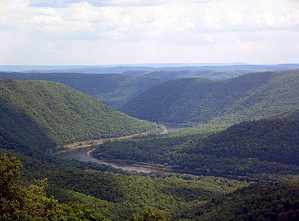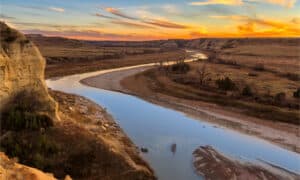It is difficult to overstate the importance of the Ohio River in the history, expansion, culture, and economy of the United States. The river flows through six states. Over 25 million people live in the Ohio River Basin. The river impacts their lives directly and indirectly. Millions more Americans, and people all over the world, utilize goods that are shipped along the river.
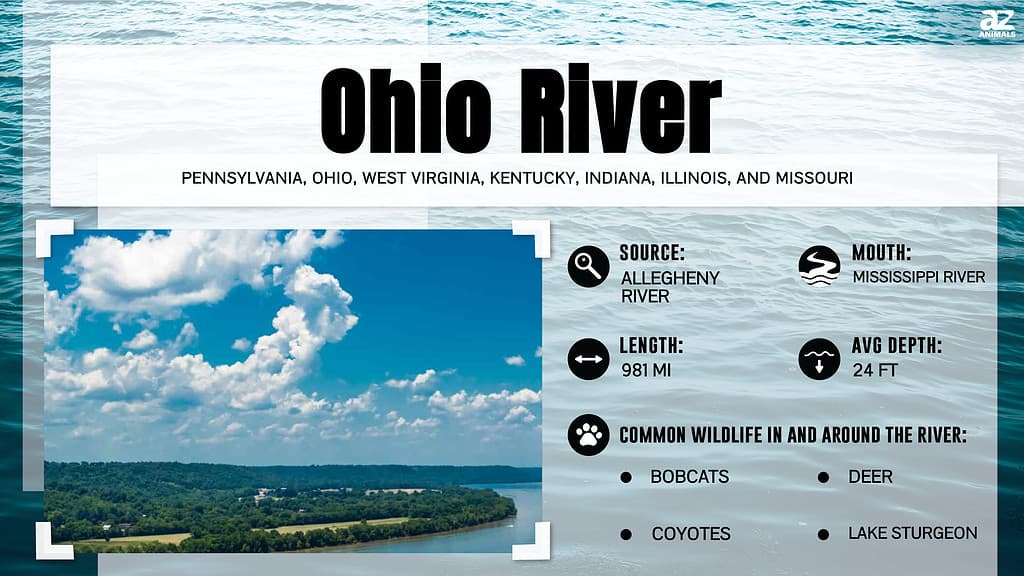
Ohio River History

The Ohio River begins in Pittsburgh, Pennsylvania.
©ESB Professional/Shutterstock.com
Native American Tribes
Human activity around the river may date back as far as 15,000 years. The Hopewell culture took shape on the banks of the Ohio some 2,000 years ago. Many native tribes and their cultures were directly tied to the river. Some of those tribes include the Cherokee, Chickasaw, Erie, Illini, Kickapoo, Lenape, Miami, Munsee, Seneca of the Iroquois Confederacy, Shawnee, Susquehannock, Wyandot, and Yuchi.
Arrival of European Settlers
Some of the first Europeans to see the river were Robert de la Salle and his expedition party in 1669. La Salle dubbed the river “La Belle Rivière” or “The Beautiful River.” The English name for the river would be derived from the Iroquois word “O-Y-O,” which means “the great river.”
France originally claimed the river’s watershed. England then claimed ownership through a purchase from Native peoples in 1744. This led to the French and Indian War which lasted from 1756 to 1763.
With its westward flow, the river served as a key transportation route during the nation’s westward expansion. It would become the southern border of the Northwest Territory.
Civil War
It also was part of the dividing line that separated free and slaveholding states in the lead-up to the Civil War. Escaped slaves crossed the Ohio River on their run to freedom via the Underground Railroad. They often referred to it as the “River Jordan,” as it symbolized their path to the “Promised Land.” More slaves escaped by crossing the Ohio River than any other dividing line that separated free and slaveholding states.
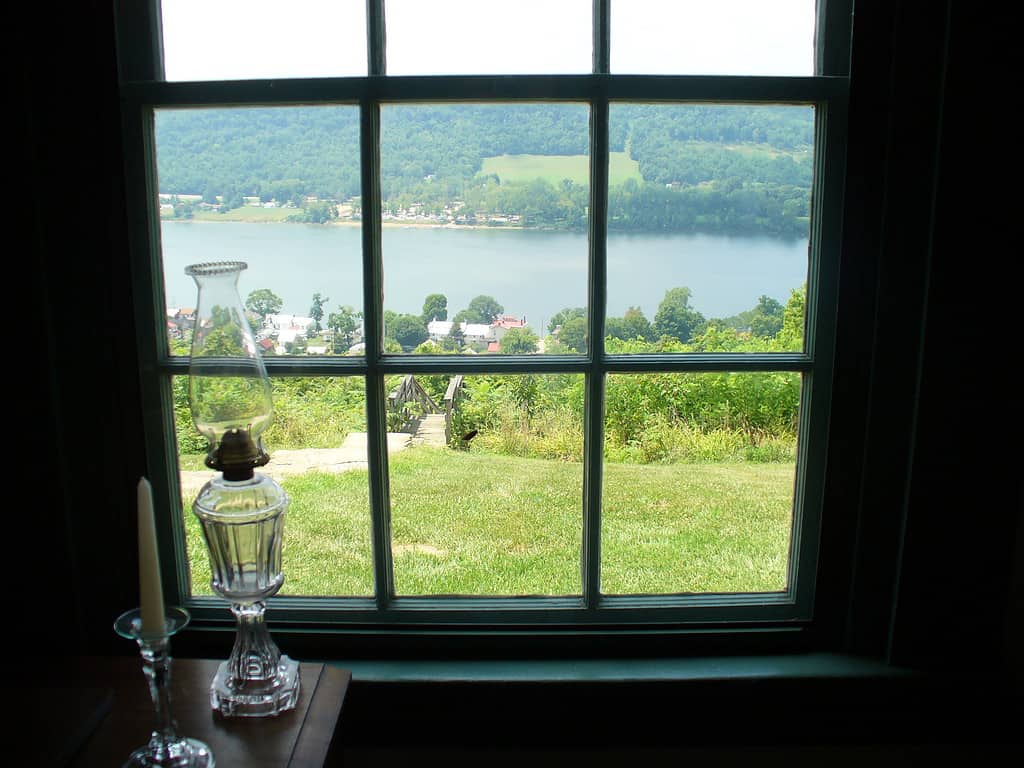
This view from the Rankin House in Ripley, Ohio, shows the area of the Ohio River where many enslaved persons crossed during their escape to freedom via the Underground Railroad.
©The original uploader was Kevin Myers at English Wikipedia / CC BY-SA 3.0 – Original / License
Commercial Importance
The mighty Ohio was an essential commercial shipping route. Sending crops and manufactured goods down the river on barges and flatboats was far more efficient and cost-effective than transporting goods by wagon over the Appalachian Mountains. Farmers and merchants could ship their goods down the Ohio River and then down the Mississippi River to New Orleans. From there, the goods could be loaded on ships bound for any number of seaports.
Boundary Marker
The river still serves as a political boundary marker, as well. It marks the state boundary lines between Ohio and West Virginia, Ohio and Kentucky, Indiana and Kentucky, and Illinois and Kentucky. Almost ten percent of the U.S. population lives in the Ohio River Basin.
Size of the River
The Ohio River is 981 miles long. The width of the river varies from half a mile to one mile wide. The widest point along the river is at Smithland Dam, west of downtown Louisville, Kentucky. The river stretches a mile wide at the dam.
The Ohio River’s average discharge at its mouth is 281 ft³/s (ft³/s = 1,000 cubic feet per second). This makes the Ohio River the third largest river in terms of discharge in the U.S., trailing only the Mississippi (593 ft³/s) and St. Lawrence (348 ft³/s) Rivers. The Ohio River is the largest tributary by volume of the Mississippi River.
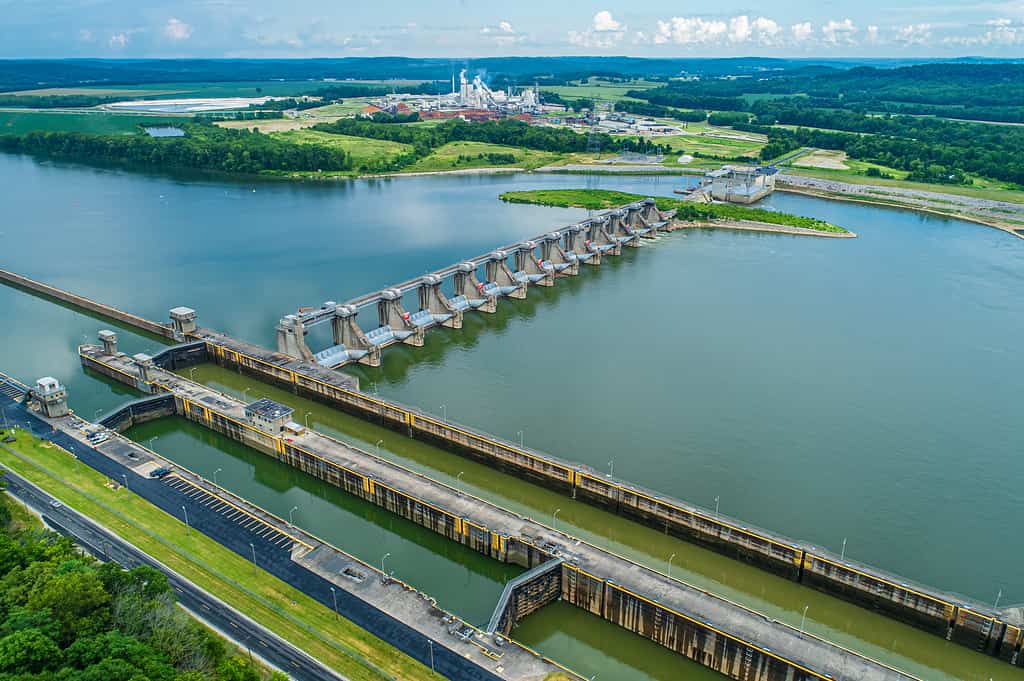
Smithland Dam represents the widest point on the 981-mile-long Ohio River.
©iStock.com/Aaron Yoder
Depth of the River
The Ohio River has an average depth of 24 feet. Its shallowest portion is from the source in Pittsburgh to Cincinnati. In Cincinnati, the river rarely rises over 30 feet. The river’s action stage (when flooding begins) in Cincinnati is 40 feet.
From Cincinnati to Louisville, the river deepens considerably. The 50 miles around Louisville represent the river’s deepest stretch. The deepest point is near Louisville, Kentucky, where the river depth extends to 130 feet.
In its natural state, the Ohio River never reached such depths. The original depth of the river ranged from 3-20 feet. Through a network of locks and dams, the river was artificially deepened, allowing for much larger and heavier freight to be moved down the Ohio.
Source of the River
Pittsburgh, Pennsylvania, is famous for its Three Rivers, comprised of the Allegheny, Monongahela, and Ohio. The confluence of the Allegheny and Monongahela Rivers at Point State Park is where the Ohio River begins. From there, the river flows 981 miles to Cairo, Illinois, where it empties into the Mississippi River.

The Allegheny and Monongahela Rivers converge in Pittsburgh at Point State Park to form the Ohio River.
Who Owns The River?
The jurisdiction of the Ohio River has been cause for debate and even legal proceedings. The United States Supreme Court finally resolved the issue beginning in 1985. Kentucky had claimed exclusive jurisdiction of the river. Ohio filed suit against Kentucky in the 1960s to dispute the claim, but it took until the 1980s for the matter to be decided.
On April 15, 1985, the Court ruled in Ohio’s favor, stating Ohio and Kentucky share concurrent jurisdiction of the river (Ohio v. Kentucky, 471 U.S. 153). Similar rulings were handed down for Indiana and Kentucky (November 4, 1985, Indiana v. Kentucky, 474 U.S. 1) and Illinois and Kentucky (May 28, 1991, Illinois v. Kentucky, 500 U.S. 380, No. 106, Orig.). There is not a shared jurisdiction of the river between Ohio and West Virginia. West Virginia currently has jurisdiction over the river along the border of the two states.
Commercial Activity
In 1917 (the first known year for such records), around five million tons of cargo was shipped along the Ohio River. Today, 180-200 million tons are moved along the Ohio River.
Urbanization and industrialization are prevalent along the banks of the Ohio. Barge traffic carries a wide variety of materials, with coal leading the way. Steel, oil, and farm products are also regularly shipped on the river.
The river flows through six states: Pennsylvania, West Virginia, Ohio, Kentucky, Indiana, and Illinois.
Major cities on the banks of the river include Pittsburgh, Huntington, West Virginia, Cincinnati, Louisville, and Evansville, Indiana.
There are many power-generating facilities along the river. It is also the drinking water source for some five million people.

The Gavin Power Plant along the Ohio River in Cheshire, Ohio, is the largest coal-fired power facility in the state.
©iStock.com/6381380
Fish in the Ohio River
A report from The Ohio State University documents 159 species of fish in the Ohio River. Some of the most popular targets for Ohio River anglers include largemouth and smallmouth bass. Temperate bass species are also often caught in the river, including white, striped, and hybrid striped bass.
Catfish proliferate in the river and are some of the biggest fish in these waters. The species include channel, flathead, and blue catfish. Sauger and walleye also swim the waters of The Ohio River, as do longnose gar and freshwater drum.
Invasive carp species such as bighead, silver, grass, and black carp are also present in the river.
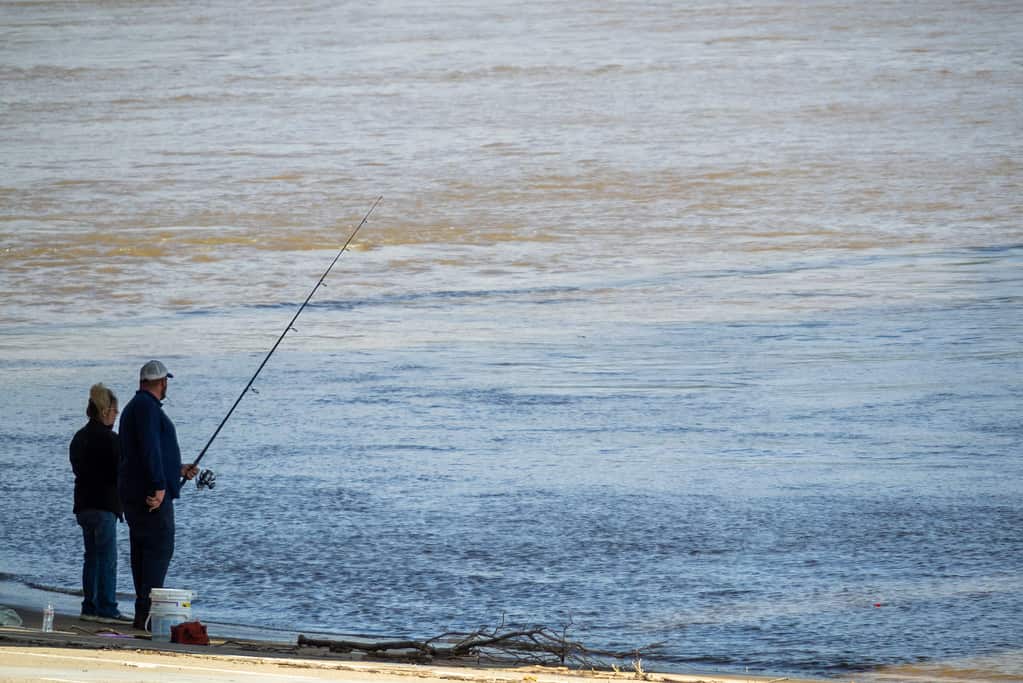
Anglers use large fishing rods and heavy tackle to land the big fish that swim in the Ohio River.
©iStock.com/Jason Whitman
Geology of the River
The Ohio River is the sixth oldest river in the United States. The earliest form of the river began to take shape around 2.5-3 million years ago when the Laurentide Ice Sheet dammed the Teays River. The upper Ohio River was created when a glacial lake overflowed into a tributary of the now-extinct Teays River.
The middle portion of the river was formed in a similar manner when an ancient lake burst and created a new route to the Mississippi River. The upper and middle sections would eventually join together, creating the modern Ohio River.
Activities on and Around the River
The Ohio River provides a wealth of activities. Fishing is one of the most popular, given the number of gamefish that inhabit the river.
Boating is also a favorite pastime on the river. Pontoons, fishing boats, and ski boats are common sights on the water. Kayaks and paddleboards also dot the river during the summer.
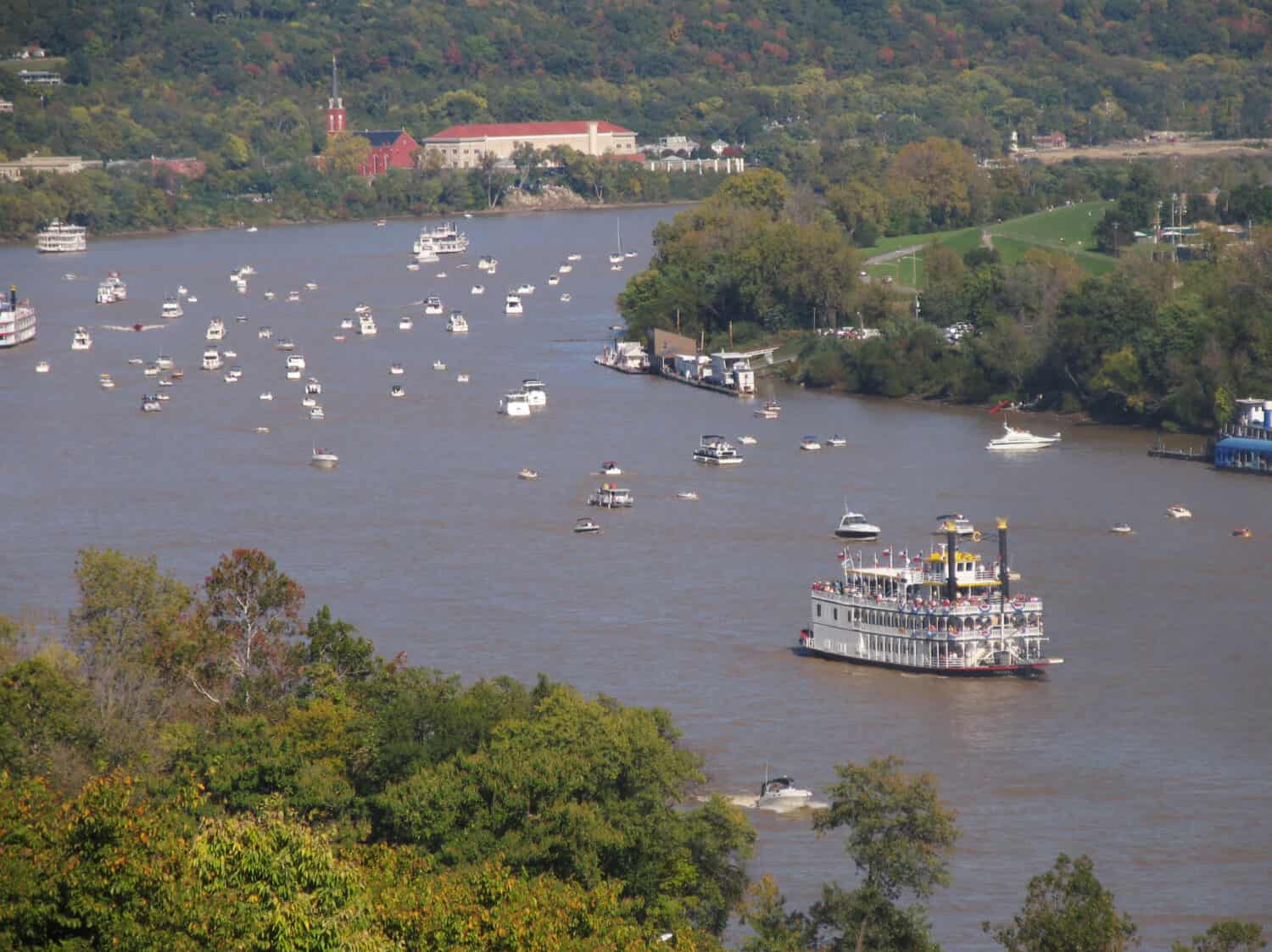
You can see boats of all kinds on the Ohio River.
©vadim kozlovsky/Shutterstock.com
Campgrounds along the river allow campers to cast a line or launch a kayak right from their campsites.
Cities along the Ohio River include the river in countless annual festivals and celebrations. Parks, restaurants, and walking trails can be found on the river banks in virtually all the major cities along the river, as well as in many of the smaller river towns.
The photo featured at the top of this post is © iStock.com/Tom Leddy
Thank you for reading! Have some feedback for us? Contact the AZ Animals editorial team.




